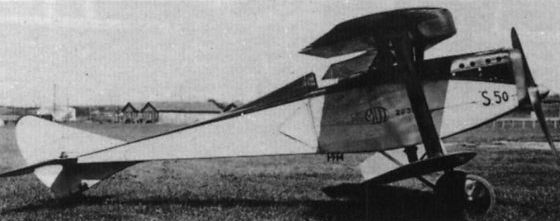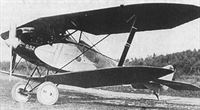SIAI MVT S.50 и S.52
В начале 1922 года Алессандро Маркетти стал главным конструктором компании SIAI. В компанию он пришел не с пустыми руками - принес проект своего самолета, созданный еще в компании "Vickers-Terni" в Ла Специи в 1917 году и получивший название MVT. Самолет выполнил первый полет на военном полигоне Монтесельо в 1919 году и продемонстрировал скорость более 260 км/ч. В 1920 году его ремоторизировали - заменили двигатель SPA 6a на более мощный SPA 6-2a мощностью 285 л.с.
Несмотря на давность разработки, конструкция самолета и в 1922 году была все еще конкурентоспособной в качестве одноместного истребителя, а согласно новой нумерации, принятой компанией SIAI после прихода нового конструктора, получила обозначение MVT S.50.
В 1923 году компания "Commissariato di Aeronautico" объявила конкурс на новый итальянский истребитель, который предполагалось оснащать двигателем Hispano-Suiza 42 мощностью 300 л.с. Маркетти спроектировал самолет, который получил обозначение S.52 и являлся переработанным вариантом S.50. Он имел схожий узкий фюзеляж, установленный между верхним и нижним крыльями, которые были необычно угловатыми и имели значительную стреловидность.
S.50 имел только рули высоты, а на S.52 стоял еще и фиксированный стабилизатор. Достаточно примитивное управление круткой крыльев у S.50 было заменено элеронами на верхнем крыле. Однако S.52 проиграл конкурс самолету Fiat CR.1 - даже несмотря на свою максимальную скорость 280 км/ч.
Показать полностьюShow all
Flight, July 1925
THE SAVOIA S.52 AND S.58 BATTLE 'PLANES
In our issue for April 9 last we published an illustrated description of some of the aircraft constructed by the Societa Idrovolanti Alta Italia (S.I.A.I.), of Sesto Calende, including the S.16 ter. flying boat on which Col. di Pinedo recently accomplished a successful flight from Rome to Australia. We also referred to certain other types constructed by this firm, and, in view of the fact that the .splendid flight referred to above has brought into prominence the name of S.I.A.I., we think it may be of interest if we give this week some brief particulars, with illustrations, of two of these other "Savoia" machines - both of the fighter class.
The two machines in question are the S.52 and the S.58. With the exception of the S.52 type, all the aircraft constructed by the S.I.A.I. have been of the flying-boat type, so that more than usual interest centres on the S.52, inasmuch as it is a land machine of the tractor fuselage type. Besides this point, however, the S.52, as may be seen from the accompanying illustrations, possesses several distinctive features in design and has decidedly pleasing lines.
In general appearance it is somewhat reminiscent of the 1914 D.F.W. biplane, with its "taube" back-swept wings, although in the case of the S.52 this feature is not very pronounced. The most important feature of the S.52 is that it is largely of metal construction. Unfortunately, however, we have been unable to obtain any constructional details of this machine.
As previously indicated, the wings, both upper and lower, are more or less of "taube" (dove) plan-form and are swept back - 6 deg. in the top plane and 5 deg. in the bottom. The bottom plane is slightly smaller in span and chord than the top plane, and is given a dihedral angle of 5 deg. An interesting feature of the wing design lies in the fact that the left-hand wings are some 3 ins. more in span than the right-hand ones, the object of which is to counteract the torque effect of the airscrew.
The top plane, which is without dihedral angle, is in two sections, joined at the centre to a pyramid cabane extending from the fuselage and further supported by a set of N-struts, one from each top side of the fuselage. The lower plane is in three sections, consisting of a short centre panel, mounted well below the fuselage, to which are attached the outer extensions. Top and bottom planes are separated by a single I-strut each side of the fuselage, sloping outwards from the lower plane, and the bracing is single streamline cables running from the strut extremities to points slightly forward of the latter - to the top of each forward N-strut in the case of the landing cables and to a point on the leading edge of the centre section, when the outer extensions are attached, in the case of the lift cables.
Ailerons are fitted to the top plane only, and these are unbalanced, but are hinged so that they form an angle of some 15 deg. to the lateral axis of the machine - in other words, when seen in plan their axes are inclined rearwards towards the centre of the fuselage. The operating cables from the joy-stick are taken up the I-struts, thence via short rods on the top of the plane to the aileron cranks.
The tail surfaces consist of two non-lifting triangular horizontal stabilising surfaces, one mounted on each side of the fuselage, located slightly above the line of thrust, to the trailing edges of which are hinged unbalanced elevators. Above and below the fuselage is a small triangular fin, to which is hinged the rudder. The lower fin carries the tail skid.
The fuselage is of good streamline shape, comparatively deep in the vicinity of the pilot's cockpit, and tapering sharply to a horizontal knife-edge at the tail. The fuselage is, we believe, built up in two sections, being divided immediately behind the cockpit. The 300 h.p. Hispano-Suiza engine is housed within a neat streamline cowling with nose radiator. The pilot's cockpit is situated just beneath the trailing edge of the top plane, the central portion of which, as well as that of the lower plane, being cut away in order to increase the pilot's range of vision - which is extremely good in this machine. Two machine guns, firing through the air-screw, are provided.
The landing chassis is of the V-type, with additional strutting at the lower plane centre section and W-bracing between the Vs.
The principal characteristics of the S.52 are :-
Span 33 ft. 4 3/4 ins. (top), 22 ft. 4 ins. (bottom).
Chord 5 ft. 6 ins. (top), 4 ft. 3 ins. (bottom).
Gap 6 ft.
O.A. length 23 ft. 7 ins.
Height 8 ft. 6 ins.
Wing area 258-24 sq.ft.
Weight empty 1,764 lbs.
„ fully laden 2,425-5 lbs.
„ per sq. ft, 9-3 lbs.
„ per H.P. 7-7 lbs.
Speed range 59-173-6 m.p.h.
Climb to 3,280 ft. 1 min. 30 secs.
„ 16,400 ft. 15 mins. 30 secs.
Range 2 1/2 - 3 1/2 hrs.
<...>
Показать полностьюShow all








